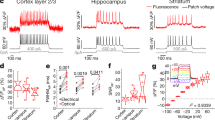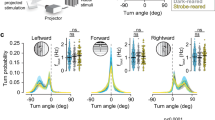Abstract
Sensory experience can elicit long-lasting plasticity of both single neurons and ensemble neural circuit response properties during embryonic development. To investigate their relationship, one must image functional responses of large neuronal populations simultaneously with single-cell resolution. In this protocol, we describe a noninvasive approach to assay functional plasticity of individual neurons and neuronal populations in vivo using targeted infusion of calcium-sensitive dyes, two-photon microscopy and synchronized visual stimuli presentations. This technique allows visualization of ∼200 neurons while probing visual responses in the optic tectum of awake, immobilized Xenopus laevis tadpoles. The protocol includes visual training paradigms that elicit long-lasting potentiation or depression of functional responses, allowing investigations of population and single-neuron plasticity induced by natural sensory stimuli in the awake, intact, developing brain. Setup time for this protocol, including dye injection and chamber preparation, is ∼2 h. Excitability probing experiments can then be performed for at least 3 h.
This is a preview of subscription content, access via your institution
Access options
Subscribe to this journal
Receive 12 print issues and online access
$259.00 per year
only $21.58 per issue
Buy this article
- Purchase on Springer Link
- Instant access to full article PDF
Prices may be subject to local taxes which are calculated during checkout




Similar content being viewed by others
References
Sin, W.C., Haas, K., Ruthazer, E.S. & Cline, H.T. Dendrite growth increased by visual activity requires NMDA receptor and Rho GTPases. Nature 419, 475–480 (2002).
Ruthazer, E.S., Akerman, C.J. & Cline, H.T. Control of axon branch dynamics by correlated activity in vivo. Science 301, 66–70 (2003).
Ramdya, P. & Engert, F. Emergence of binocular functional properties in a monocular neural circuit. Nat. Neurosci. 11, 1083–1090 (2008).
Haas, K., Li, J.L. & Cline, H.T. AMPA receptors regulate experience-dependent dendritic arbor growth in vivo. Proc. Natl. Acad. Sci.USA 103, 12127–12131 (2006).
Cline, H. & Haas, K. The regulation of dendritic arbor development and plasticity by glutamatergic synaptic input: a review of the synaptotrophic hypothesis. J. Physiol. (London) 586, 1509–1517 (2008).
Aizenman, C.D., Akerman, C.J., Jensen, K.R. & Cline, H.T. Visually driven regulation of intrinsic neuronal excitability improves stimulus detection in vivo. Neuron 39, 831–842 (2003).
Aizenman, C.D., Munoz-Elias, G. & Cline, H.T. Visually driven modulation of glutamatergic synaptic transmission is mediated by the regulation of intracellular polyamines. Neuron 34, 623–634 (2002).
Zhang, L.I., Tao, H.W. & Poo, M. Visual input induces long-term potentiation of developing retinotectal synapses. Nat. Neurosci. 3, 708–715 (2000).
Engert, F., Tao, H.W., Zhang, L.I. & Poo, M.M. Moving visual stimuli rapidly induce direction sensitivity of developing tectal neurons. Nature 419, 470–475 (2002).
Espinosa, J.S., Wheeler, D.G., Tsien, R.W. & Luo, L. Uncoupling dendrite growth and patterning: single-cell knockout analysis of NMDA receptor 2B. Neuron 62, 205–17 (2009).
Wiesel, T.N. & Hubel, D.H. Single cell responses in striate cortex of kittens deprived of vision in one eye. J. Neurophysiol. 26, 1003–1017 (1963).
Gordon, J.A. & Stryker, M.P. Experience-dependent plasticity of binocular responses in the primary visual cortex of the mouse. J. Neurosci. 16, 3274–3286 (1996).
Gaze, R.M., Keating, M.J. & Chung, S.H. The evolution of the retinotectal map during development in Xenopus. Proc. R. Soc. Lond., B Biol. Sci. 185, 301–330 (1974).
Sretavan, D. & Shatz, C.J. Prenatal development of individual retinogeniculate axons during the period of segregation. Nature 308, 845–848 (1984).
Sakaguchi, D.S. & Murphey, R.K. Map formation in the developing Xenopus retinotectal system: an examination of ganglion cell terminal arborizations. J. Neurosci. 5, 3228–3245 (1985).
Vislay-Meltzer, R.L., Kampff, A.R. & Engert, F. Spatiotemporal specificity of neuronal activity directs the modification of receptive fields in the developing retinotectal system. Neuron 50, 101–114 (2006).
Dunfield, D. & Haas, K. Metaplasticity governs natural experience-driven plasticity of nascent embryonic brain circuits. Neuron 64, 240–250 (2009).
Zhou, Q., Tao, H.W. & Poo, M.M. Reversal and stabilization of synaptic modifications in a developing visual system. Science 300, 1953–1957 (2003).
Wong, R.O. Calcium imaging and multielectrode recordings of global patterns of activity in the developing nervous system. Histochem. J. 30, 217–229 (1998).
Takahashi, N., Sasaki, T., Usami, A., Matsuki, N. & Ikegaya, Y. Watching neuronal circuit dynamics through functional multineuron calcium imaging (fMCI). Neurosci. Res. 58, 219–225 (2007).
Johenning, F.W. & Holthoff, K. Nuclear calcium signals during L-LTP induction do not predict the degree of synaptic potentiation. Cell Calcium 41, 271–283 (2007).
Stocca, G., Schmidt-Hieber, C. & Bischofberger, J. Differential dendritic Ca2+ signalling in young and mature hippocampal granule cells. J. Physiol. 586, 3795–3811 (2008).
Brustein, E., Marandi, N., Kovalchuk, Y., Drapeau, P. & Konnerth, A. 'In vivo' monitoring of neuronal network activity in zebrafish by two-photon Ca2+ imaging. Pflugers Arch. 446, 766–773 (2003).
Niell, C.M. & Smith, S.J. Functional imaging reveals rapid development of visual response properties in the zebrafish tectum. Neuron 45, 941–951 (2005).
Fetcho, J.R., Cox, K.J. & O'Malley, D.M. Monitoring activity in neuronal populations with single-cell resolution in a behaving vertebrate. Histochem. J. 30, 153–167 (1998).
Ramdya, P., Reiter, B. & Engert, F. Reverse correlation of rapid calcium signals in the zebrafish optic tectum in vivo. J. Neurosci. Methods 157, 230–237 (2006).
Yaksi, E. & Friedrich, R.W. Reconstruction of firing rate changes across neuronal populations by temporally deconvolved Ca2+ imaging. Nat. Methods 3, 377–383 (2006).
Sumbre, G., Muto, A., Baier, H. & Poo, M.-m. Entrained rhythmic activities of neuronal ensembles as perceptual memory of time interval. Nature 456, 102–106 (2008).
Smetters, D., Majewska, A. & Yuste, R. Detecting action potentials in neuronal populations with calcium imaging. Methods 18, 215–221 (1999).
Kerr, J.N.D., Greenberg, D. & Helmchen, F. Imaging input and output of neocortical networks in vivo. Proc. Natl. Acad. Sci. USA 102, 14063–14068 (2005).
Greenberg, D.S., Houweling, A.R. & Kerr, J.N.D. Population imaging of ongoing neuronal activity in the visual cortex of awake rats. Nat. Neurosci. 11, 749–751 (2008).
Sasaki, T., Takahashi, N., Matsuki, N. & Ikegaya, Y. Fast and accurate detection of action potentials from somatic calcium fluctuations. J. Neurophysiol. 100, 1668–1676 (2008).
Junek, S., Chen, T., Alevra, M. & Schild, D. Activity correlation imaging: visualizing function and structure of neuronal populations. Biophys. J. 96, 3801–3809 (2009).
Zhang, L.I., Tao, H.W., Holt, C.E., Harris, W.A. & Poo, M. A critical window for cooperation and competition among developing retinotectal synapses. Nature 395, 37–44 (1998).
Tao, H.W. & Poo, M.M. Activity-dependent matching of excitatory and inhibitory inputs during refinement of visual receptive fields. Neuron 45, 829–836 (2005).
Mu, Y. & Poo, M.M. Spike timing-dependent LTP/LTD mediates visual experience-dependent plasticity in a developing retinotectal system. Neuron 50, 115–125 (2006).
Nieuwkoop, P.D. & Faber, J. Normal Table of Xenopus Laevis (North Holland, Amsterdam, 1967).
Chen, C. Heterosynaptic LTP in early development. Neuron 31, 510–512 (2001).
Bhatt, D.H., Otto, S.J., Depoister, B. & Fetcho, J.R. Cyclic AMP-induced repair of zebrafish spinal circuits. Science 305, 254–258 (2004).
Stosiek, C., Garaschuk, O., Holthoff, K. & Konnerth, A. In vivo two-photon calcium imaging of neuronal networks. Proc. Natl. Acad. Sci. USA 100, 7319–7324 (2003).
Xu, C. Two-photon cross sections of indicators. in Imaging Neurons: A Laboratory Manual (ed. R. Yuste, F. Lanni & A. Konnerth) 191–199 (Cold Spring Harbor Press, Cold Spring Harbor, New York, 2000).
Tao, H.W., Zhang, L.I., Engert, F. & Poo, M. Emergence of input specificity of ltp during development of retinotectal connections in vivo. Neuron 31, 569–580 (2001).
Thévenaz, P., Ruttimann, U.E. & Unser, M. A pyramid approach to subpixel registration based on intensity. IEEE Trans. Image Process. 7, 27–41 (1998).
Sperry, R.W. Chemoaffinity in the orderly growth of nerve fiber patterns and connections. Proc. Natl. Acad. Sci. USA 50, 703–710 (1963).
Acknowledgements
This work was supported by the National Science and Engineering Council of Canada, the Canadian Institute of Health Research, the Michael Smith Foundation for Health Research, the Canadian Foundation for Innovation, The EJLB Foundation and the Human Early Learning Project.
Author information
Authors and Affiliations
Corresponding author
Rights and permissions
About this article
Cite this article
Dunfield, D., Haas, K. In vivo single-cell excitability probing of neuronal ensembles in the intact and awake developing Xenopus brain. Nat Protoc 5, 841–848 (2010). https://doi.org/10.1038/nprot.2010.10
Published:
Issue Date:
DOI: https://doi.org/10.1038/nprot.2010.10
This article is cited by
-
Normal and abnormal coding of somatosensory stimuli causing pain
Nature Neuroscience (2014)
Comments
By submitting a comment you agree to abide by our Terms and Community Guidelines. If you find something abusive or that does not comply with our terms or guidelines please flag it as inappropriate.



